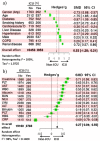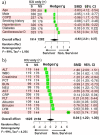Risk of mortality in COVID-19 patients: a meta- and network analysis
- PMID: 36747045
- PMCID: PMC9901837
- DOI: 10.1038/s41598-023-29364-8
Risk of mortality in COVID-19 patients: a meta- and network analysis
Abstract
Understanding the most relevant hematological/biochemical characteristics, pre-existing health conditions and complications in survivors and non-survivor will aid in predicting COVID-19 patient mortality, as well as intensive care unit (ICU) referral and death. A literature review was conducted for COVID-19 mortality in PubMed, Scopus, and various preprint servers (bioRxiv, medRxiv and SSRN), with 97 observational studies and preprints, consisting of survivor and non-survivor sub-populations. This meta/network analysis comprised 19,014 COVID-19 patients, consisting of 14,359 survivors and 4655 non-survivors. Meta and network analyses were performed using META-MAR V2.7.0 and PAST software. The study revealed that non-survivors of COVID-19 had elevated levels of gamma-glutamyl transferase and creatinine, as well as a higher number of neutrophils. Non-survivors had fewer lymphocytes and platelets, as well as lower hemoglobin and albumin concentrations. Age, hypertension, and cerebrovascular disease were shown to be the most influential risk factors among non-survivors. The most common complication among non-survivors was heart failure, followed by septic shock and respiratory failure. Platelet counts, creatinine, aspartate aminotransferase, albumin, and blood urea nitrogen levels were all linked to ICU admission. Hemoglobin levels preferred non-ICU patients. Lower levels of hemoglobin, lymphocytes, and albumin were associated with increased mortality in ICU patients. This meta-analysis showed that inexpensive and fast biochemical and hematological tests, as well as pre-existing conditions and complications, can be used to estimate the risk of mortality in COVID-19 patients.
© 2023. The Author(s).
Conflict of interest statement
The authors declare no competing interests.
Figures







References
-
- Wu Z, McGoogan JM. Characteristics of and important lessons from the coronavirus disease 2019 (COVID-19) outbreak in China: Summary of a report of 72314 cases from the Chinese center for disease control and prevention. JAMA. 2020;323:1239–1242. - PubMed
Publication types
MeSH terms
Substances
LinkOut - more resources
Full Text Sources
Medical
Miscellaneous

